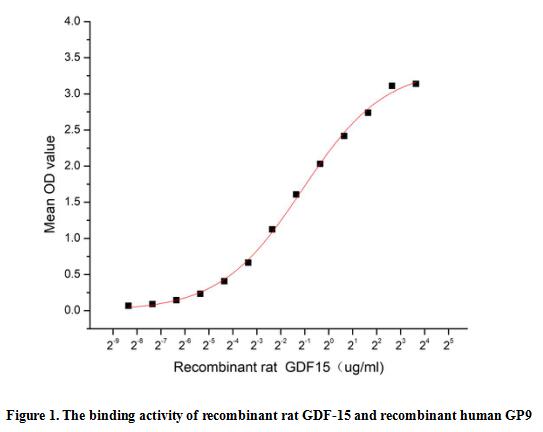Active Growth Differentiation Factor 15 (GDF15)
PDF; MIC1; NAG-1; PLAB; PTGFB; Macrophage inhibitory cytokine 1; NSAID-activated gene 1 protein; Placental bone morphogenetic protein; Prostate differentiation factor
- Product No.APC034Ra01
- Organism SpeciesRattus norvegicus (Rat) Same name, Different species.
- Buffer FormulationPBS, pH7.4, containing 0.01% SKL, 5% Trehalose.
- TraitsFreeze-dried powder
- Purity> 97%
- Isoelectric Point6.9
- ApplicationsCell culture; Activity Assays.
- Download Instruction Manual
- UOM 10µg50µg 200µg 1mg 5mg
-
FOB
US$
For more details, please contact local distributors!US$
For more details, please contact local distributors! US$
For more details, please contact local distributors! US$
For more details, please contact local distributors! US$
For more details, please contact local distributors!
ACTIVITY TEST of the Active Growth Differentiation Factor 15 (GDF15)

Growth Differentiation Factor 15 (GDF-15), also called Macrophage Inhibitory Cytokine 1 (MIC-1), is a divergent member of the Transforming Growth Factor beta (TGF-beta) superfamily. Human GDF-15 shares 66% and 68% amino acid sequence identity with the rat and mouse proteins, respectively. GDF-15 is highly expressed in placenta and brain, and it is expressed at lower levels in kidney, pancreas, prostate, and colon. Similar to other TGF-beta family proteins, GDF-15 is synthesized as a large precursor protein that is cleaved at a dibasic cleavage site (RxxR) to release the mature protein. Biologically active GDF-15 is a disulfide-linked homodimer of the mature protein. GDF 15 has been shown to have various functions, including inhibition of Tumor Necrosis Factor alpha (TNF-alpha) production from lipopolysaccharide-stimulated macrophages and the induction of cartilage formation. A functional binding ELISA assay was conducted to detect the interaction of recombinant rat GDF-15 and recombinant human GP9. Briefly, GDF-15 was diluted serially in PBS with 0.01% BSA (pH 7.4). Duplicate samples of 100 μl were then transferred to GP9-coated microtiter wells and incubated for 1h at 37℃. Wells were washed with PBST and incubated for 1h with anti-GDF-15 pAb, then aspirated and washed 3 times. After incubation with HRP labelled secondary antibody for 1h at 37℃, wells were aspirated and washed 5 times. With the addition of substrate solution, wells were incubated 15-25 minutes at 37℃. Finally, add 50 µL stop solution to the wells and read at 450/630 nm immediately. The binding activity of GDF-15 and GP9 was shown in Figure 1, the EC50 for this effect is 0.47 ug/mL.
USAGE of the Active Growth Differentiation Factor 15 (GDF15)
Reconstitute in 10mM PBS (pH7.4) to a concentration of 0.1-1.0 mg/mL. Do not vortex.
STORAGE of the Active Growth Differentiation Factor 15 (GDF15)
Avoid repeated freeze/thaw cycles. Store at 2-8°C for one month. Aliquot and store at -80°C for 12 months.
STABILITY of the Active Growth Differentiation Factor 15 (GDF15)
The thermal stability is described by the loss rate. The loss rate was determined by accelerated thermal degradation test, that is, incubate the protein at 37°C for 48h, and no obvious degradation and precipitation were observed. The loss rate is less than 5% within the expiration date under appropriate storage condition.
INCREMENT SERVICES
BCA Protein Quantification Kit
Molecular Mass Marker for Protein
Monoclonal Antibody Customized Service
Polyclonal Antibody Customized Service
Protein Activity Test Experiment Service
Electrophoretic Mobility Shift Assay (EMSA) Experiment Service
Buffer
Lentivirus Packaging Experiment Service
Adenovirus Packaging Experiment Service
Real Time PCR Experimental Service
Spike RBD Protein (S-RBD)
Protein G
Protein A
Related products
| Catalog No. | Organism species: Rattus norvegicus (Rat) | Applications (RESEARCH USE ONLY!) |
| RPC034Ra01 | Recombinant Growth Differentiation Factor 15 (GDF15) | Positive Control; Immunogen; SDS-PAGE; WB. |
| APC034Ra01 | Active Growth Differentiation Factor 15 (GDF15) | Cell culture; Activity Assays. |
| PAC034Ra01 | Polyclonal Antibody to Growth Differentiation Factor 15 (GDF15) | WB; IHC; ICC; IP. |
| LAC034Ra71 | Biotin-Linked Polyclonal Antibody to Growth Differentiation Factor 15 (GDF15) | WB; IHC; ICC. |
| MAC034Ra21 | Monoclonal Antibody to Growth Differentiation Factor 15 (GDF15) | WB; IHC; ICC; IP. |
| SEC034Ra | ELISA Kit for Growth Differentiation Factor 15 (GDF15) | Enzyme-linked immunosorbent assay for Antigen Detection. |
| SCC034Ra | CLIA Kit for Growth Differentiation Factor 15 (GDF15) | Chemiluminescent immunoassay for Antigen Detection. |
| LMC034Ra | Multiplex Assay Kit for Growth Differentiation Factor 15 (GDF15) ,etc. by FLIA (Flow Luminescence Immunoassay) | FLIA Kit for Antigen Detection. |

